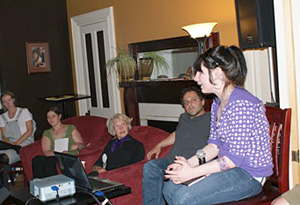 |
| Katie Crane talks about her experiences living homeless in Canada atВ last week'sВ CafГ© Scientifique (Elana LibermanВ photo) |
All of Katie CraneвҖҷs drawings have unfinished faces: aВ mother holding her baby, a young man leaning against a brick wall, all nameless, faceless representations of her time spent living on the streets.
After being asked to leave her Dartmouth group home at 16,В Ms.В CraneВ spent the next seven years homeless, traveling across the country and doing what she could to get by. Hers is the story of many homeless youth across Canada, struggling to survive despite living in one of the wealthiest countries in the world.
So how do youth likeВ Ms. CraneВ make it to the streets? How do they fall through the cracks, and how do we help them out? These were just some of the questions posed at last week's CafГ© Scientifique, an informal discussion series sponsored by the Canadian Institutes of Health Research.
РВјУЖВБщәПІКҝӘҪұЦұІҘ professors Jean Hughes of the School of Nursing and Jeff Karabanow of the School of Social Work led the discussion with Ms. Crane, each providing their own unique perspective on the issue.
вҖңI have a degree in the streets,вҖқВ Ms. CraneВ joked during her introduction to the more than 25 people packed into the upstairs seating area of Just Us CafГ© on Spring Garden. вҖңStreet kids come from every kind of background there is. ItвҖҷs really a whole different world out there.вҖқ
SheВ is currentlyВ drawing the illustrations for Dr. Karabanow's new book Voices from the Streets: How Canadian Homeless Young People are Getting Off the Street. And although she is no longer homeless, she still struggles with being on her own.
вҖңI feel like IвҖҷm in the middle in a lot of ways,вҖқ she admits. вҖңWhen youвҖҷre on the streets, short-term thinking gets in the way of long-term planning. Changing that way of thinking is still hard.вҖқ
HerВ struggles are not unique to youth starting over after years of homelessness. For many, itвҖҷs difficult to feel accepted again in normal society.
 |
| Tim Crooks (left), executive director of Phoenix Youth Programs, chats with Jean Hughes (centre) andВ Jeff Karabanow (right) at the CafГ© Scientifique. (Elana LibermanВ photo) |
вҖңI think people might be surprised by the sense of community these youth encounter,вҖқ says Dr. Karabanow, whose research focuses on pathways in and out of homelessness. вҖңTypically youth who end up on the streets are dealing with some kind of high-level trauma in their lives. For many, street culture may be one of the first communities that truly accepts them for who they are.вҖқ
Dr. Karabanow admits there is more to the issue than acceptance though, identifying poverty, lack of affordable housing and inadequate school and social support systems as contributing factors as well.
вҖңSome people want to shift the blame to the individual, thinking people should just pull themselves up by the bootstraps,вҖқ he says. вҖңThis thinking doesnвҖҷt acknowledge that we live in a very mean economic and political system that pushes people to the brink.вҖқ
Everyone at the discussion was hopeful Nova ScotiaвҖҷs new NDP government would do more to alleviate some of the root causes of youth homelessness in the province.
вҖңYouth are the fastest growing homeless population in Canada, followed closely by young families,вҖқ says Dr. Hughes, who researches mental illness in homeless youth. вҖңThis discussion is a great step toward engaging the public. ItвҖҷs important to know that, in the end, these youth want the exact same things as you or I.вҖқ
In her research Dr. Hughes found that 50 per cent of youth she interviewed at Phoenix House, a local youth housing project, had a diagnosable level of mental illness.
вҖңJust trying to survive each day takes its toll,вҖқ she explains. вҖңSomething as simple as using the washroom is a struggle. I can get into a washroom anywhere in this city, but a lot of homeless youth cannot.вҖқ
Despite the challenges, both Dr. Hughes and Dr. Karabanow are still amazed by the amount of hope they encounter in the youth they work with.В Ms. Crane, though, says that it takes community leadership to provide that hope.
вҖңI was given the opportunity to have hope,вҖқ says Katie. вҖңI was lucky enough to meet people to walk beside me and show me the way; I never could have changed my life without them.вҖқ
